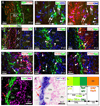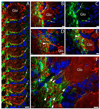Activation of the Wnt/beta-catenin signaling reporter in developing mouse olfactory nerve layer marks a specialized subgroup of olfactory ensheathing cells
- PMID: 18816448
- PMCID: PMC2895989
- DOI: 10.1002/dvdy.21712
Activation of the Wnt/beta-catenin signaling reporter in developing mouse olfactory nerve layer marks a specialized subgroup of olfactory ensheathing cells
Abstract
Wnt reporter TOPgal mice carry a beta-galactosidase (betagal) gene under the control of the Wnt/beta-catenin signaling responsive elements. We found that the intensely immunolabeled betagal+ cells were co-immunolabeled with Nestin and formed a tangentially oriented single-cell layer in the "connecting or docking zone" where the olfactory sensory axons attached to the brain surface during mid-gestation. During early postnatal development, betagal+ cells were located in the inner olfactory nerve layer (ONLi) and co-labeled with olfactory ensheathing cell (OEC) markers S100beta and NPY but not with lineage-specific markers for neurons, oligodendrocytes, astrocytes, and microglia, demonstrating that the TOPgal marked a subpopulation of OECs. By confocal microscopy, we found that TOPgal activated processes extended along the developing glomerulus and formed multiple tunnel-like structures that ensheathe and bridge olfactory sensory axonal bundles from ONLi to the glomerulus, which may play a key role in glomerulus formation and convergent sorting of the peripheral olfactory axons.
Copyright (c) 2008 Wiley-Liss, Inc.
Figures





Similar articles
-
Transcription factor Runx1 inhibits proliferation and promotes developmental maturation in a selected population of inner olfactory nerve layer olfactory ensheathing cells.Gene. 2014 May 1;540(2):191-200. doi: 10.1016/j.gene.2014.02.038. Epub 2014 Feb 26. Gene. 2014. PMID: 24582971
-
A unique cell population in the mouse olfactory bulb displays nuclear beta-catenin signaling during development and olfactory sensory neuron regeneration.Dev Neurobiol. 2008 Jun;68(7):859-69. doi: 10.1002/dneu.20606. Dev Neurobiol. 2008. PMID: 18327767
-
Wnt/Frizzled family members mediate olfactory sensory neuron axon extension.J Comp Neurol. 2008 Nov 20;511(3):301-17. doi: 10.1002/cne.21834. J Comp Neurol. 2008. PMID: 18803244 Free PMC article.
-
The potential therapeutic applications of olfactory ensheathing cells in regenerative medicine.Cell Transplant. 2014;23(4-5):567-71. doi: 10.3727/096368914X678508. Cell Transplant. 2014. PMID: 24816451 Review.
-
Wnt/β-Catenin Signaling Pathway Governs a Full Program for Dopaminergic Neuron Survival, Neurorescue and Regeneration in the MPTP Mouse Model of Parkinson's Disease.Int J Mol Sci. 2018 Nov 24;19(12):3743. doi: 10.3390/ijms19123743. Int J Mol Sci. 2018. PMID: 30477246 Free PMC article. Review.
Cited by
-
A sensitive and bright single-cell resolution live imaging reporter of Wnt/ß-catenin signaling in the mouse.BMC Dev Biol. 2010 Dec 21;10:121. doi: 10.1186/1471-213X-10-121. BMC Dev Biol. 2010. PMID: 21176145 Free PMC article.
-
Designing Olfactory Ensheathing Cell Transplantation Therapies: Influence of Cell Microenvironment.Cell Transplant. 2022 Jan-Dec;31:9636897221125685. doi: 10.1177/09636897221125685. Cell Transplant. 2022. PMID: 36124646 Free PMC article. Review.
-
Conditioned medium of Wnt/β-catenin signaling-activated olfactory ensheathing cells promotes synaptogenesis and neurite growth in vitro.Cell Mol Neurobiol. 2013 Oct;33(7):983-90. doi: 10.1007/s10571-013-9966-z. Epub 2013 Jul 28. Cell Mol Neurobiol. 2013. PMID: 23893371 Free PMC article.
-
Dishevelled proteins are associated with olfactory sensory neuron presynaptic terminals.PLoS One. 2013;8(2):e56561. doi: 10.1371/journal.pone.0056561. Epub 2013 Feb 20. PLoS One. 2013. PMID: 23437169 Free PMC article.
-
Canonical Wnt signaling promotes the proliferation and neurogenesis of peripheral olfactory stem cells during postnatal development and adult regeneration.J Cell Sci. 2011 May 1;124(Pt 9):1553-63. doi: 10.1242/jcs.080580. Epub 2011 Apr 12. J Cell Sci. 2011. PMID: 21486944 Free PMC article.
References
-
- Aoki K, Osumi-Yamashita N, Ninomiya Y, Eto K. Differential expression of NCAM, vimentin and MAP1B during initial pathfinding of olfactory receptor neurons in the mouse embryo. Anat Embryol (Berl) 1995;192:211–220. - PubMed
-
- Au E, Roskams AJ. Olfactory ensheathing cells of the lamina propria in vivo and in vitro. Glia. 2003;41:224–236. - PubMed
-
- Au WW, Treloar HB, Greer CA. Sublaminar organization of the mouse olfactory bulb nerve layer. J Comp Neurol. 2002;446:68–80. - PubMed
-
- Bailey MS, Puche AC, Shipley MT. Development of the olfactory bulb: evidence for glia-neuron interactions in glomerular formation. J Comp Neurol. 1999;415:423–448. - PubMed
-
- Balmer CW, LaMantia AS. Noses and neurons: induction, morphogenesis, and neuronal differentiation in the peripheral olfactory pathway. Dev Dyn. 2005;234:464–481. - PubMed
Publication types
MeSH terms
Substances
Grants and funding
LinkOut - more resources
Full Text Sources
Other Literature Sources
Miscellaneous

